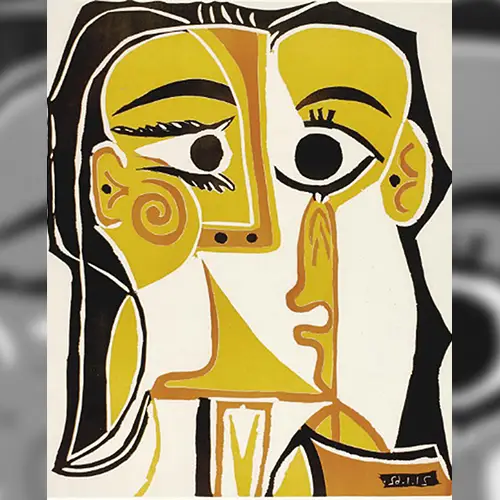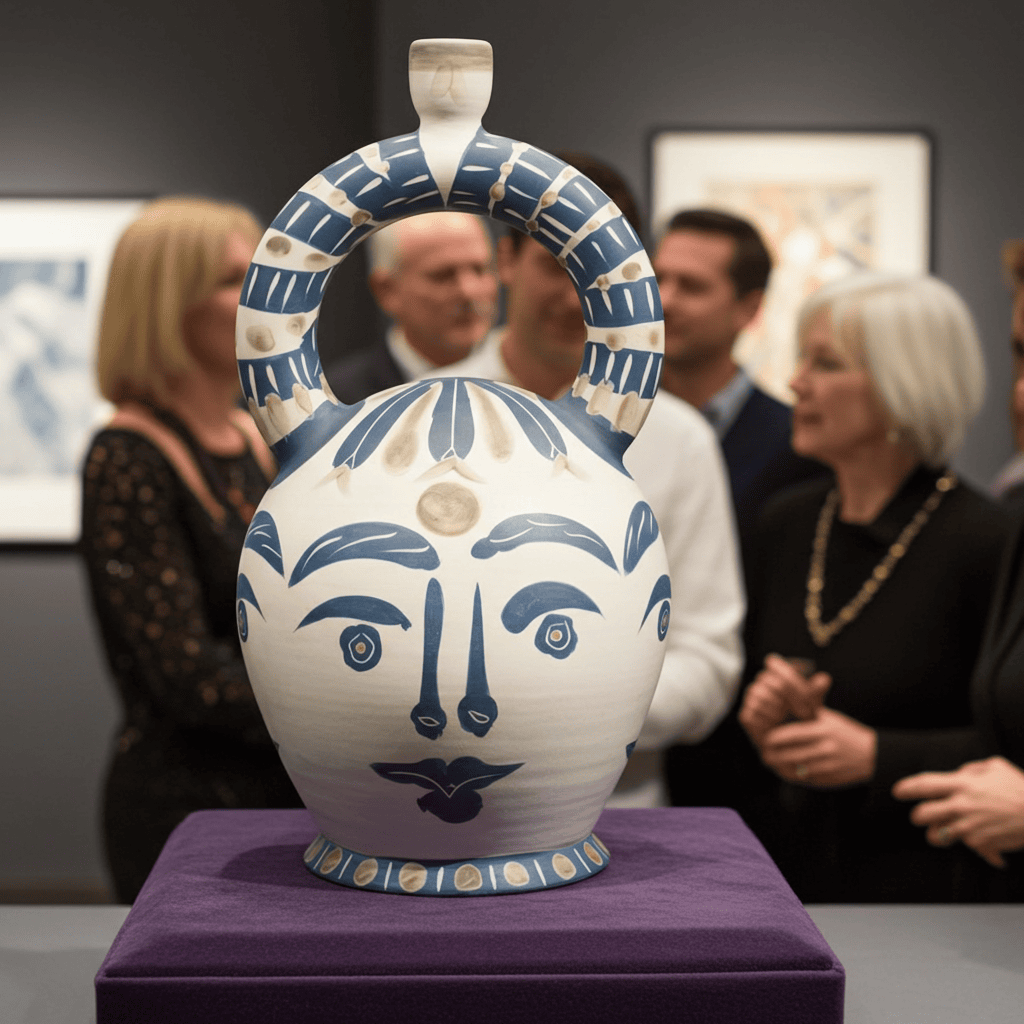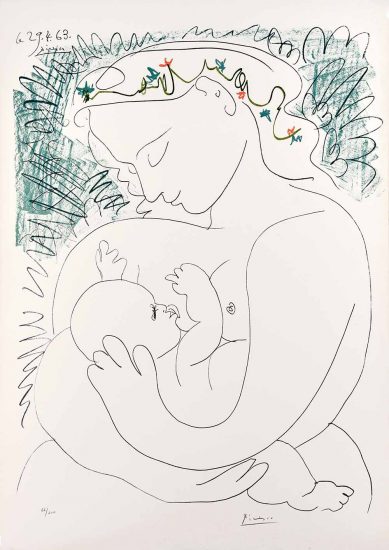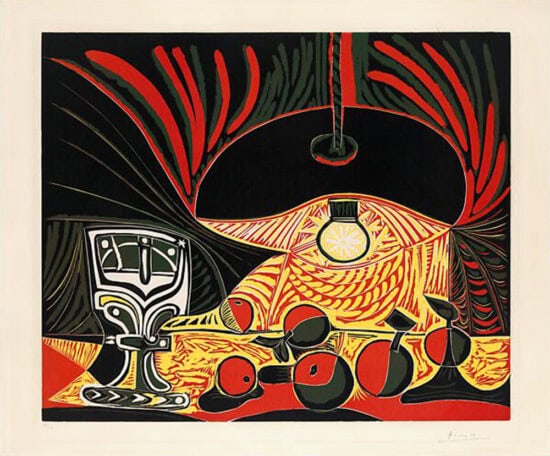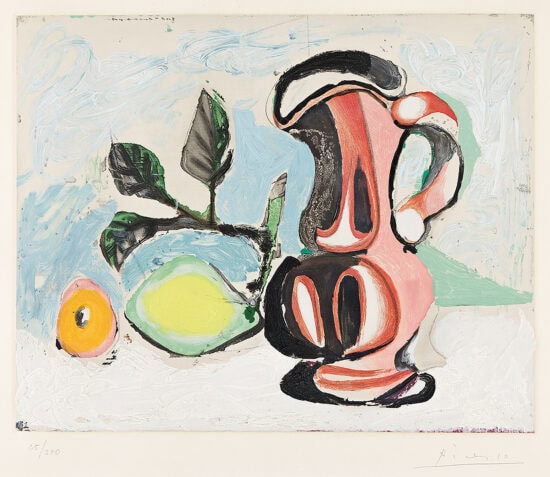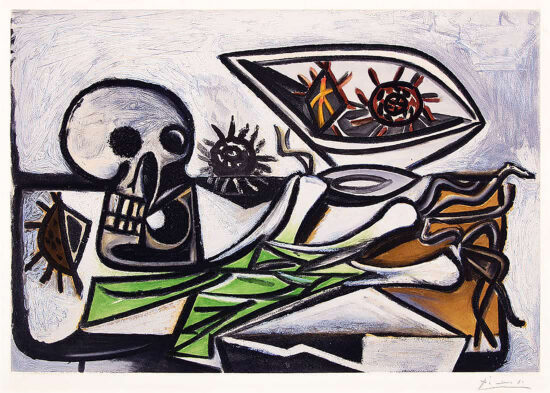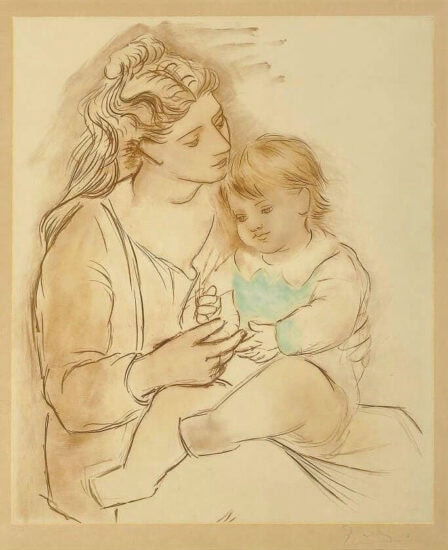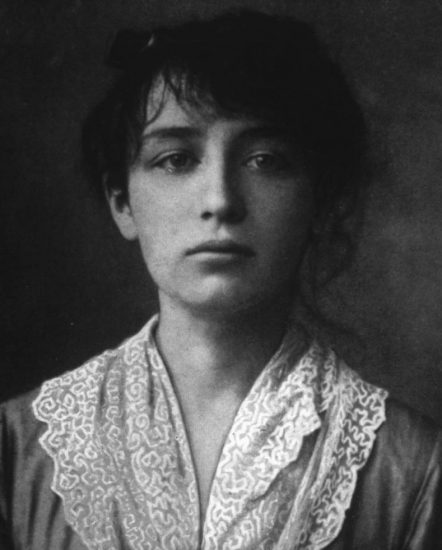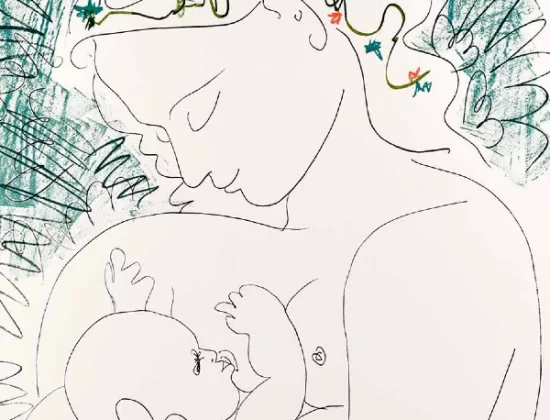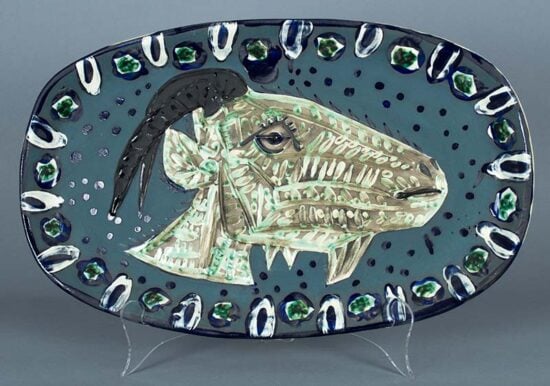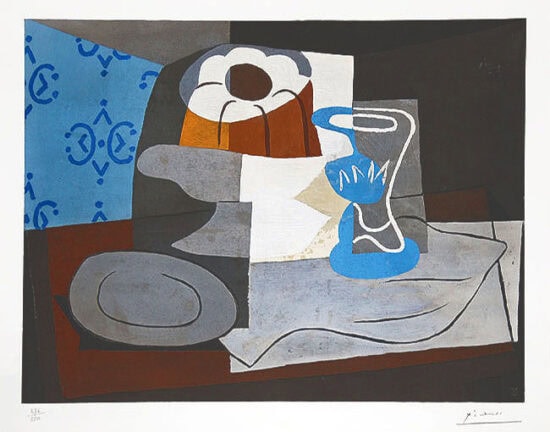Pablo Picasso returned repeatedly to the theme of mother and child, exploring it as both a deeply personal and universally resonant subject. These works allowed him to probe the intimate bond between caregiver and child—the tenderness, dependence, and protective love that defines human connection—while simultaneously experimenting with form, line, and composition. Drawing on centuries of artistic tradition, from Renaissance depictions of the Madonna and Child to Iberian and African sculptural influences, Picasso reinterpreted the motif with his characteristic inventiveness, at times elongating forms, distorting perspectives, or simplifying contours to emphasize emotion over literal representation. In his Blue Period, mother-and-child images convey melancholy and human vulnerability, reflecting broader social concerns and the fragility of life, while in later periods, they can express warmth, playfulness, and the joy of familial intimacy. The subject also mirrored his own life—his relationships with women, the births of his children, and his observations of domestic life infused these works with immediacy and authenticity. By repeatedly revisiting this motif, Picasso transformed a timeless archetype into a canvas for both emotional depth and radical artistic exploration, fusing personal experience, cultural memory, and formal innovation into a body of work that remains profoundly moving and unmistakably his own.
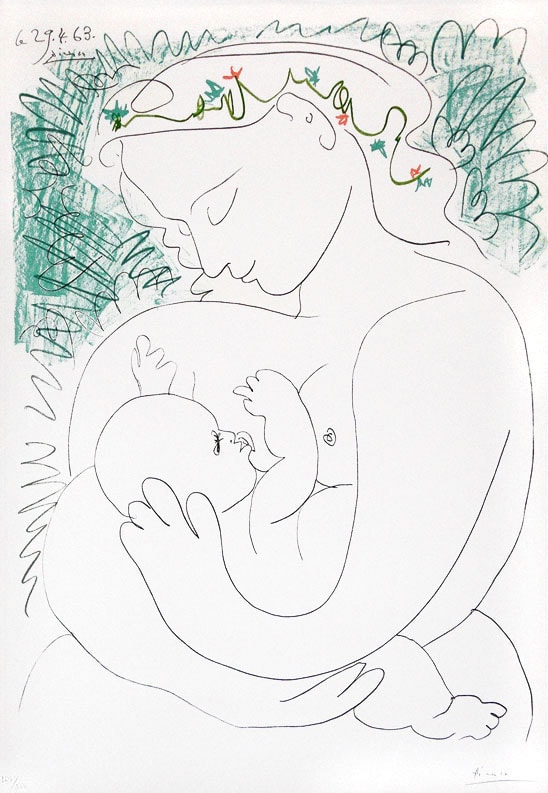
Did Picasso create Mother and Child artworks during his Rose Period?
Yes, Pablo Picasso did create mother-and-child works during his Rose Period (1904–1906), though they are less numerous than in his Blue Period. During the Rose Period, his palette shifted from the somber blues to warmer pinks, ochres, and earthy tones, and his subjects often included circus performers, harlequins, and families, reflecting a more tender, lyrical mood.
In these works, the mother-and-child motif conveys warmth, intimacy, and gentle affection rather than melancholy. Picasso’s forms become softer, more rounded, and more lyrical, with figures often depicted in close, protective embraces. While the Blue Period emphasized emotional suffering and human vulnerability, the Rose Period iterations of mother-and-child celebrate life, familial closeness, and the nurturing bond, reflecting both his evolving personal circumstances and the more optimistic tone of his work at the time.
Some notable examples include small paintings and sketches where mothers cradle their children, often with simplified contours, flowing lines, and muted but warm colors, blending the universality of the theme with the expressive lyricism characteristic of the Rose Period.
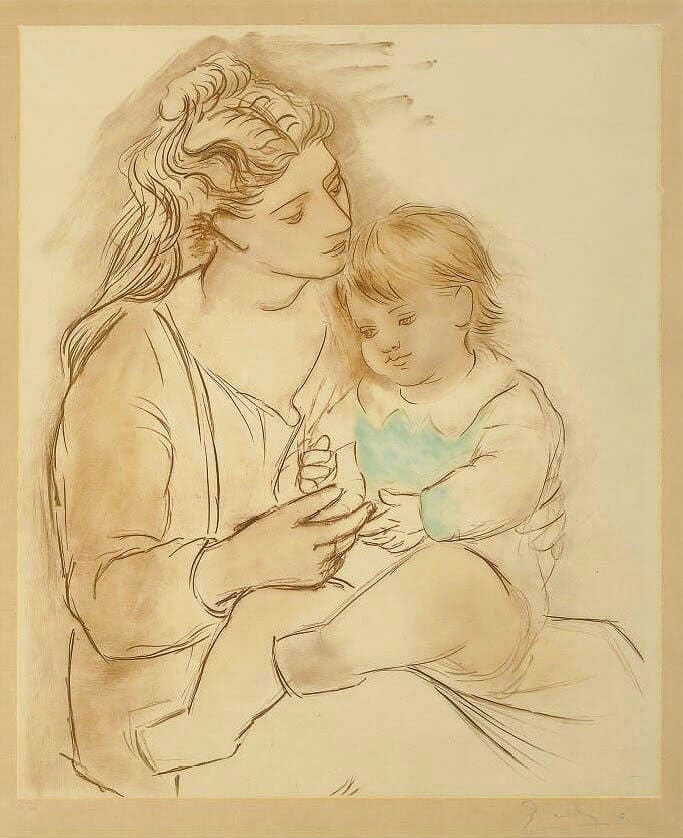
Did Picasso create Mother and Child artworks during his Cubist Period?
During his Cubist period, Pablo Picasso reimagined the timeless motif of mother and child with a revolutionary approach that merged emotional intimacy with radical formal experimentation. Rather than depicting the bond through traditional gestures or soft, naturalistic forms, Picasso deconstructed the figures into interlocking planes, geometric facets, and multiple perspectives, creating compositions in which mother and child emerge simultaneously as both distinct and inseparable entities. The emotional connection—the protective embrace, the shared presence—remains palpable, yet it is conveyed through spatial relationships, angular lines, and overlapping shapes, reflecting the Cubist pursuit of representing the totality of experience rather than a singular moment. In these works, the mother and child are transformed into architectural forms of feeling, where the solidity of the mother’s figure anchors the composition and the child’s presence is hinted at through dynamic, intersecting volumes. This radical abstraction allows Picasso to explore the essence of nurturing, dependence, and human intimacy while pushing the boundaries of visual language, demonstrating that even the most universal themes can be reinvented through innovative perception and structural ingenuity. The result is a body of work in which emotional resonance and avant-garde formalism coexist seamlessly, revealing both the timelessness of maternal bonds and the daring intellect of Picasso’s Cubist vision.
Famous Picasso Mother and Child works in Museums:
1. “Mother and Child” (1901) – Blue Period Harvard Art Museums, Cambridge, Massachusetts, USA.
2. “Mother and Child” (1902) Fogg Museum, part of the Harvard Art Museums, Cambridge, Massachusetts, USA.
3. “Mother and Child” (1905) – Rose Period Musée d'Orsay, Paris, France.
4. “Mother and Child” (1921) Art Institute of Chicago, Chicago, Illinois, USA.
5. “Mother and Child” (1930s) Baltimore Museum of Art, Baltimore, Maryland, USA.
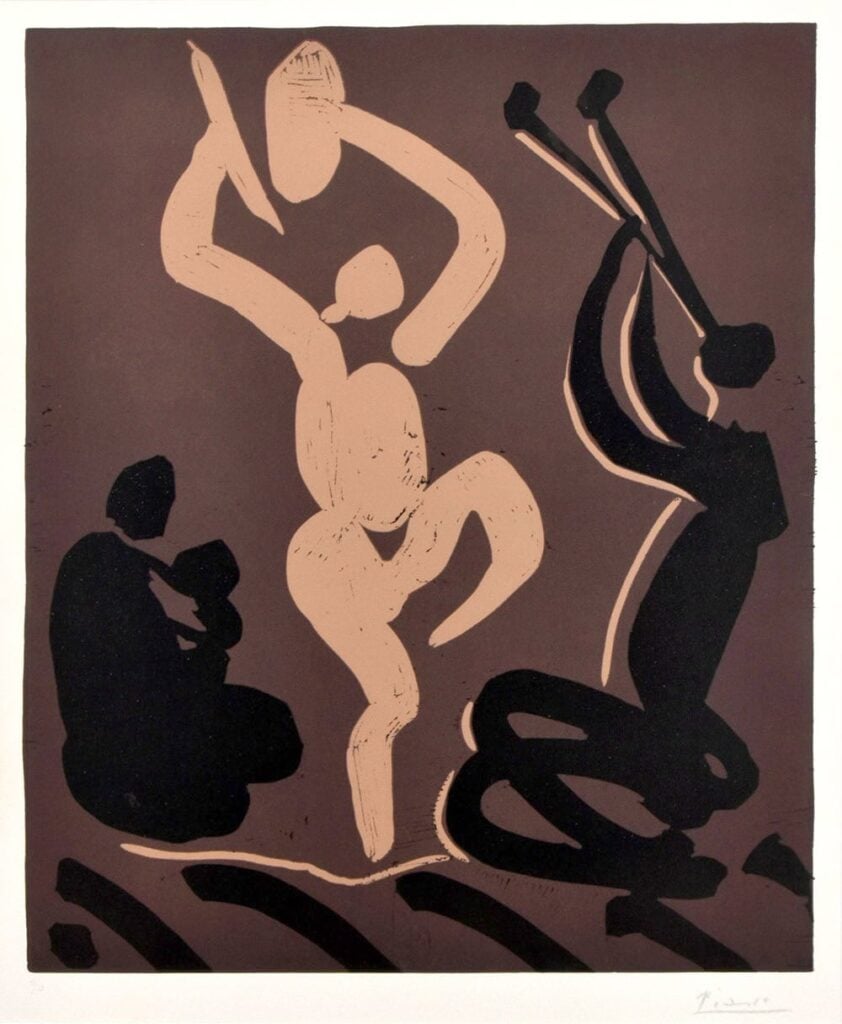
Famous Picasso Mother and Child Exhibitions:
1. "Picasso and Chicago" – Art Institute of Chicago (2013–2014)
This comprehensive exhibition showcased over 250 works by Picasso, including his iconic "Mother and Child" paintings. The 1921 oil painting Mother and Child, inspired by the birth of his son Paulo, was a central piece, reflecting Picasso's return to classical forms during his Neoclassical period.
2. "Picasso and Paper" – Cleveland Museum of Art (2024–2025)
This exhibition focused on Picasso's innovative use of paper in his artistic process. Among the works displayed was Mother and Child (Study for Mother and Child), a preparatory drawing that exemplifies his exploration of maternal themes through various mediums.
3. "Picasso and the Mediterranean" – Musée Picasso, Antibes (2017)
Held at the Musée Picasso in Antibes, this exhibition examined Picasso's relationship with the Mediterranean region and its influence on his work. Several of his "Mother and Child" paintings were featured, illustrating how the coastal environment inspired his depictions of maternal figures.
4. "Picasso: The Mediterranean Years" – Musée Picasso, Vallauris (2018)
This exhibition focused on Picasso's time in the South of France, particularly Vallauris, where he lived and worked for many years. It included several "Mother and Child" artworks, highlighting how his surroundings influenced his portrayal of familial themes.
Picasso Mother and Child Drawings:
Pablo Picasso created numerous mother-and-child drawings throughout his career, many of which are celebrated for their emotional intimacy, elegance, and innovative use of line. These drawings often served as preparatory studies for paintings or sculptures, but many stand on their own as masterful expressions of form, emotion, and abstraction. Some of the most famous include:
1. “Mother and Child” (1901–1902) – Blue Period - A delicate yet somber ink or charcoal drawing emphasizing the fragility and emotional depth of the mother-child bond.
2. “Mother and Child” Studies (1905) – Rose Period - Drawings in pencil or watercolor that soften the contours and employ warmer tones.
3. Cubist Mother and Child Drawings (1907–1912) - Sketches and preparatory drawings that fragment the figures into geometric planes.
4. “Mother and Child” Lithograph and Ink Drawings (1920s–1930s) - Picasso explored variations in line, contour, and minimalism.
5. Later Mother and Child Drawings (1940s–1950s) - Often rendered in pencil or ink on paper, reflecting his mature style.
Picasso Mother and Child Ceramics
Pablo Picasso also explored the mother-and-child theme in ceramics, particularly during his time in Vallauris, France (late 1940s–1950s), when he collaborated extensively with the Madoura Pottery Studio. These ceramic works reveal his fascination with form, texture, and playful experimentation, while continuing his lifelong exploration of maternal intimacy and human connection. This is a common theme in art history depicting women as caring more than controlling.
1. “Mother and Child” Vase (circa 1949–1952) - A large earthenware vase painted with simplified, stylized figures of a mother cradling her child.
2. Ceramic Plates and Bowls Featuring Mother and Child - Often decorated with linear drawings, incised or painted onto the curved surfaces of plates and bowls.
3. Sculptural Mother-and-Child Pieces - Some small sculptural ceramic works depict mothers holding children or embracing figures.
Picasso Mother and Child Lithographs
Pablo Picasso’s mother-and-child lithographs stand as exquisite examples of his ability to fuse emotional intimacy with formal innovation, capturing the universal bond between parent and child through economy of line and expressive abstraction. Unlike his paintings or ceramics, the lithographic medium allowed Picasso to distill his subjects to their essential contours, creating works that are at once immediate and timeless. In these lithographs, the mother often appears as a simplified, almost archetypal figure, cradling or embracing her child in gestures that convey tenderness, protection, and profound human connection. Some of the most celebrated prints from the 1930s show flowing, uninterrupted lines that define the figures’ forms with elegance and clarity, while others explore abstraction, breaking the figures into geometric or overlapping shapes, yet never sacrificing the emotional resonance at the heart of the motif. These works reflect Picasso’s enduring fascination with maternal relationships, a theme that he revisited across decades and mediums, from the melancholy of his Blue Period to the lyricism of the Rose Period and the radical formal experiments of his later years. Today, Picasso’s mother-and-child lithographs are housed in major collections around the world—including the Musée Picasso in Paris, the Museum of Modern Art in New York, the Art Institute of Chicago, and the British Museum in London—where they continue to captivate audiences with their blend of simplicity, sophistication, and timeless human empathy.
1. “Mother and Child” (1930s)
2. “Maternité” (Motherhood) – 1930s
3. Preparatory Mother-and-Child Lithographs for Larger Works
4. “Mère et Enfant” (Mother and Child), 1932–1935
5. “Mother and Child” (Étude), 1930s
6. “Maternité” (Study for Print), circa 1935
Later lithographs feature stylized, almost playful depictions of mothers and children, integrating geometric abstraction and bold contour lines.
Notable Picasso Mother-and-Child Etchings
“Mère et Enfant” (Mother and Child), 1921 – A tender, finely detailed etching emphasizing intimacy and naturalistic forms.
“Maternité” (Motherhood), 1924 – Focuses on the protective gesture of the mother, with flowing, elegant lines.
“Mother and Child” (Étude), circa 1930 – A study etching showing simplified forms and subtle abstract tendencies.
“Mère et Enfant” (Cubist Etching), 1932 – Incorporates geometric abstraction while maintaining the emotional essence of the bond.
“Mother and Child” (Variations), 1940s–1950s – Later etchings feature stylized, playful figures emphasizing form, gesture, and rhythm.
These etchings exemplify Picasso’s versatility across mediums, demonstrating how a classic theme can be continually reinvented while maintaining profound emotional resonance.
Picasso Mother and Child: Quick Facts & Tidbits
Q: Why did Picasso repeatedly paint Mother and Child?
The motif allowed him to explore intimacy, protection, and human vulnerability while experimenting with form, line, and abstraction across different periods.
Q: When did Picasso first explore the theme of Mother and Child?
During his Blue Period (1901–1904), often depicting melancholy, fragile figures in tender embraces.
Q: How did Picasso’s Mothern and Child theme evolve in his Rose Period?
Forms became softer, colors warmer, and the depictions more lyrical, reflecting optimism, affection, and playfulness.
Q: Did Picasso incorporate Mother and Child into Cubism?
Yes—he abstracted the figures into geometric planes and overlapping perspectives, preserving emotional resonance while radically reinterpreting form.
Q: Did Picasso explore the Mother and Child motif in other mediums?
Absolutely. Picasso’s mother-and-child appeared in: Paintings – Blue, Rose, Neoclassical periods. Drawings – Charcoal, pencil, ink. Lithographs & Etchings – Streamlined, expressive line work. Ceramics – Especially during his Vallauris years, often playful and sculptural. Sculptures – Including small figures and abstracted forms.
Q: Did Picasso Mother and Child artworks have a personal connections to his life?
Yes—his relationships with women, the births of his children (Paulo, Maya, Claude, Paloma), and observation of domestic life inspired many intimate depictions.
Q: Why is Picasso’s Mother and Child theme considered iconic in his work?
It bridges timeless human emotion with Picasso’s experimental approach, allowing him to innovate across styles while maintaining universal appeal.
Q: Any quirky tidbits?
Some drawings were preparatory sketches for paintings or ceramics, yet often became celebrated works in their own right.
Even in Cubist abstractions, viewers can often “read” the mother-child connection through gesture and composition.
Picasso sometimes revisited the theme decades later, showing its persistent emotional and artistic significance.
Q: Where can Picasso’s Mother and Child artworks be found today?
Major collections include:
Musée Picasso, Paris
Musée National Picasso, Vallauris
Art Institute of Chicago
Museum of Modern Art (MoMA), New York
Harvard Art Museums
What Muses did Picasso use for his Mother and Child artworks?
1. Fernande Olivier. Picasso’s companion during the Rose Period (1904–1906).
While there are no widely known mother-and-child paintings directly of Fernande with a child, she influenced his early explorations of maternal intimacy and domestic life.
2. Olga Khokhlova. Picasso’s first wife and mother of his son Paulo.
She appears in several Neoclassical mother-and-child works from the 1920s, where Picasso depicted her nurturing their child in classical, monumental forms.
3. Marie-Thérèse Walter. Picasso’s muse and mother of his daughter Maya.
Many late 1930s and early 1940s mother-and-child images feature Marie-Thérèse as a figure, often idealized and curvaceous, reflecting both affection and sensuality.
4. Dora Maar. Picasso’s muse during the late 1930s and 1940s.
Some sketches and lithographs of mothers and children from this period are thought to be inspired by Dora, though often stylized or abstracted in his Cubist and Surrealist-influenced style.
5. Françoise Gilot. Picasso’s partner and mother of Claude and Paloma.
In the 1940s–1950s, she appears in both paintings and sketches as a maternal figure, inspiring tender works that combine abstraction with warmth.

